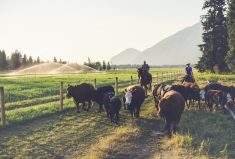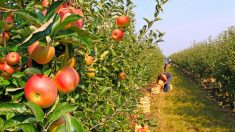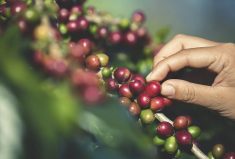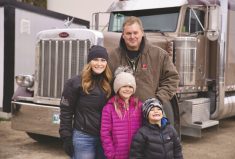A brand isn’t a Nike swoosh. It’s what the Nike swoosh makes you think. On the farm, it isn’t a yellow deer jumping across a green background. It’s all the ideas — the thoughts, feelings and expectations — that that deer calls up.
Few jobs are more studded with brands than farming. Farmers fill their equipment sheds with brands, they seed and spray their fields with brands, they even wear them.
Now, the farm itself is becoming a brand, with more farms across the country putting more thought into how they can use modern marketing so buyers, input suppliers, and just about everyone else will see that doing business with their farm is the right thing for them to do.
Read Also

Farmland values: assumptions and realities
Where farmland values are headed and what decisions farmers should make
It’s all based on the idea that everyone has a brand. Whether you think you do or don’t is beside the point. It’s like how your neighbours have an idea whether you’re lazy or hard-working, or whether you’re friendly or stand-offish, without you actually telling them.
The difference is, with modern branding you take charge of what you want others — especially the people you do business with — do think of you. Then you use branding strategies to make sure those ideas get imbedded.
It raises a question, though. Why would you want to stand out?
Elysia Vandenhurk, chief revenue officer (CRO) of Three Farmers, a company founded over a decade ago by Saskatchewan farmers Colin Rosengren, Ron Emde and Dan Vandenhurk, had a crystal clear reason for wanting to brand their enterprise. They were breaking new ground, trying to get buyers they hadn’t yet met to want to buy a kind of oil none of them had ever used.
Over this past decade, however, Three Farmers’ need for branding has evolved into something even more sophisticated, now that it is also a consumer packed-goods company that produces and markets snack foods made from various pulses as well as cold-pressed camelina oil.
Country Guide has talked with Three Farmers in the past, and we went back to Vandenhurk again to see what her key brand learnings have been through that decade.
To Vandenhurk, it’s been a voyage discovering that so many of the benefits that branding experts talk about can also be immensely valuable for farm businesses.
What does that mean? “Your brand is the persona that goes out there but it also is what leads the culture of your internal people and communicates your values,” Vandenhurk says.
“The brand is something that threads through everything your company does, how you hire, who you hire, how you make decisions, the products and services you put out there. It’s the core element that threads through the company and leads the success of the company.”
At Three Farmers today, it is Elysia and sister Natasha who handle the day-to-day running of the company. Natasha, who is currently CEO, has a degree in business economics from the University of Saskatchewan, and Elysia is a Red Seal Chef. They are using their combination of education and training to move the company to the next level, which depends on them creating a Three Farmers brand identity that is recognized worldwide.
“We have a unique structure because we have the three initial founding farmers, then myself and my sister, who are also founders, and we are daughters of farmers but a different generation with different skillsets,” Vandenhurk says. “Right out of the gate, we had a really good team around the table that offered very different skills and value.”
But even with oodles of talent around the table from the outset, one of their biggest strengths was recognizing the skills they didn’t have and approaching a professional marketing agency to fill the gaps.
“When we decided we were going to pursue a food product made from camelina, we went to a marketing agency right away because we knew we were moving into consumer-packaged goods,” Vandenhurk says. “We knew that we needed to bring this idea to life in a creative form … We needed a brand, a story and a creative look to go with the quality and functionality of what the product is.”
Building a brand identity
A brand identity answers the big question of why someone would ever want to do business with you instead of some other farm somewhere else.
“Why me? What is my unique differentiator?” asks Vandenurk. “That is the point that you need to hit home.”
In a way, it’s more straightforward for Three Farmers than for most farms. They’ve got a product to sell based on their unique food and snack skills. But it’s more than that too. They also have a core set of values which makes them good people to do business with.

At its core, though, it’s the same for any farm. The principals of any farm might start by asking themselves why they farm. What are your values and beliefs? How are those beliefs reflected in the way you farm and the products the farm produces? What is the culture and personality of your farm? How does the farm stand out?
“Write out your story,” Vandenhurk says. “Then reach out of your comfort zone.” Take a buyer out to lunch and tell them your story. See what they react to. Test your story with others too. Even consider urbanites who know nothing about farming. If you write a long paragraph about your farm — the kind of thing you often see on websites — what parts of it do people react to?
The odds, says Vandenhurk, are that you’ll be wrong about what they latch onto. “Something we learned along the way is that what we think is going to sell, or what we think people want to hear, isn’t actually that. It’s a different piece of the story they want to hear,” she says.
In fact, it’s good advice across the board.
Farms are feeling more pressure to differentiate themselves in some way and to brand themselves as progressive or technologically innovative, or as leaders in things like stewardship or eco-friendly practices because consumers are demanding to know more about where their food comes from and the people who grow it.
“Listen to your audience and to the consumer,” Vandenhurk says. “How are they evolving? What are the questions they’re asking and what are the pain points they have? The pain points change and evolve but if you have a product or service out there, and you are no longer filling a gap or conveniently solving some sort of pain point then you become irrelevant.”
For Three Farmers, the process is continuous. They constantly invite feedback and validate the brand, especially via their social media channels.
“Our social channels are kind of a community where the consumer comes to ask more questions,” Vandenhurk says. “We want to know who is coming to our channels and why are they there? How did they get there? How did they hear about us? What content are they looking for? Is it educational, is it fun content, what are they there for?”
There’s a valuable lesson at the bottom of it, Vandenhurk says. “There are so many different messages and so many things we want to say, but sometimes when you say too much you don’t say anything.”
Spending the money
Building a brand is likely going to cost some money and it can be hard sometimes to see the value of that investment, especially for commodity-based farms that don’t have a direct connection to the end-consumer.
“You have to put money into a brand to bring it to life, and people can struggle with the value of that sometimes, especially at the farm gate,” Vandenhurk says. “But a brand is a tool that’s used for your internal culture, for how you hire people, the partners you partner with, the people you do business with. It can be used as a very effective tool in building success for your business. It helps you make decisions, because when you have refined the things that go into your brand, your decisions and innovations always ladder back to it.”
How to get started
Tim Young, founder of Small Farm Nation, says the basic ideas are simple. Farms are unique businesses that need a strong business brand to thrive, he says. And deciding what the brand should focus on is almost always an easy choice.
“The heart of any farm business is the farmer,” says Young. “The best farms are those where the farmer has established something of a personal brand.”
Young started his career in corporate America but left to start a marketing agency in 1995 that grew to 450 employees. But Young says he began wanting to do something that was more “soul-satisfying,” so he sold the business in 2006 and began a pastured-livestock and artisan cheese business on a farm in Georgia. Now, under the banner of Small Farm Nation, he offers marketing courses and website and branding services to farmers across the U.S.
The Small Farm Nation website and blog are loaded with tips to help farmers get started on branding their farm business, and Young has given permission to Country Guide to reproduce a Canadianized version, which we have adapted below:
Take a stand.
Leaders take stands, whether it’s for something (i.e. sustainability) or against something else (poor customer service). So take a stand but frame your message with a positive outcome for the consumer. Don’t just rant about what’s wrong; paint a vision of how the world would be better off with your vision. We’re drawn to people with vision.
Be consistently present.
Leaders show up. For most farms, this is what blogging, social media and content marketing are all about. If you’re larger, you might use public relations and the media. Either way, just get out there with your message, consistently.
Create sound bites.
A sound bite is a message that you distill into a few words. This becomes a “repeatable nugget” where the goal is to help people recall what you said and why you said it. Put in the time to distill your message into sound bites so it is easy for others to carry your torch. Begin building a personal farm brand by creating a powerful sound bite that is reflective of your farm brand. It should be less than nine seconds long to read: the shorter the better. The average sound bite today is seven seconds. Then use the sound bite consistently to reinforce your brand message and include it in quotes in social media image headers.
It’s not about you. It’s about them.
You’re the change agent. Your customer is the beneficiary. Your goal is to change the world or create something for their benefit. Once they clearly understand how they benefit and why the change you represent is much better for them, they’ll hop aboard your train.
Show the real you.
Particularly on social media, show the real you. This means it’s not all business all the time. Share something personal about yourself, whether it’s talking about your family or sharing a picture of you in a ridiculous Halloween costume with your kids, or at a social gathering. Be real, because you want people to relate to you as a real person, not a corporate icon.
Be transparent.
Have the courage to be vulnerable. Let people know your worries, or that you make mistakes. It shows you are human and builds empathy. Don’t always try to be “right.” You’re taking a stand, you’re pursuing a better way of life, but you are still a human.
Help ‘them’ to get involved.
Think about how your audience can take action or get involved and engage with you in some way. What do you want them to do? Your followers need you to guide them to the actions that will help you to succeed as the change agent you represent. Don’t just deliver the message; tell them what they need to do to help you achieve the vision.
Act one to many: think one to one.
The best way to build your brand might be to sit down with each person individually, but that’s not realistic. Instead, we have to use technology. In that sense, we’re acting as one to many. We create one post and distribute it to many people, which is a better leverage of your time. However, your message needs to sound like one-to-one so the listener feels you are speaking directly to them. Farmers who excel at this are relatable and their messages always resonate. That’s the goal. It’s an art, but one you can master.
















